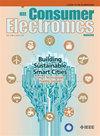Sensing–Communication–Computing Integrated Resource Allocation for AI-Empowered Trustworthy IoT
IF 4.3
2区 计算机科学
Q1 ENGINEERING, ELECTRICAL & ELECTRONIC
引用次数: 0
Abstract
Advancements in 5G, cognitive Internet of Things (IoT), and Artificial Intelligence (AI) technologies have revolutionized consumer electronics in smart grids. AI-empowered IoT enables efficient data processing and decision support, providing significant benefits alongside security challenges. While blockchain ensures trustworthy data sharing, transaction management, and attack protection, consumer electronics still face threats from resource allocation fragmentation, device access adversary, and paradox between data processing and blockchain consensus. Therefore, a joint optimization problem for sensing-communication-computing multi-dimensional resource allocation is constructed. By jointly optimizing the time scheduling ratio, channel allocation, power control, and computing resource allocation, it minimizes the combined delay of device-to-device transmission, data computing queuing, and blockchain authentication. Then, the problem is decoupled and solved in two stages. In the first stage, the adversarial Deep Q-network (DQN) based joint optimization algorithm of time scheduling, channel allocation, and power control method is proposed. It achieves adversary awareness by augmenting DQN with edge-end collaborative Signal-to-Interference plus Noise Ratio (SINR) ranking. In the second stage, a delay and security tradeoff computing resource allocation method is proposed to jointly guarantee low-latency data processing and high-security blockchain consensus. Simulation results demonstrate that our algorithm effectively reduces data processing delay and enhances blockchain authentication security.基于ai的可信赖物联网感知-通信-计算集成资源分配
5G、认知物联网(IoT)和人工智能(AI)技术的进步彻底改变了智能电网中的消费电子产品。人工智能支持的物联网实现了高效的数据处理和决策支持,在面临安全挑战的同时也带来了巨大的好处。虽然区块链确保了可信的数据共享、事务管理和攻击防护,但消费类电子产品仍然面临来自资源分配碎片、设备访问对手以及数据处理与区块链共识之间的悖论的威胁。为此,构造了一个感知-通信-计算多维资源分配的联合优化问题。通过共同优化时间调度比例、通道分配、功率控制和计算资源分配,最大限度地降低设备间传输、数据计算排队和区块链认证的综合延迟。然后,将问题解耦并分两个阶段求解。首先,提出了基于深度q网络(DQN)的时间调度、信道分配和功率控制的联合优化算法。它通过边缘协同信噪比(SINR)排序来增强DQN,从而实现对手感知。第二阶段,提出一种延迟与安全权衡的计算资源分配方法,共同保证低延迟数据处理和高安全区块链共识。仿真结果表明,该算法有效地降低了数据处理延迟,提高了区块链认证的安全性。
本文章由计算机程序翻译,如有差异,请以英文原文为准。
求助全文
约1分钟内获得全文
求助全文
来源期刊
CiteScore
7.70
自引率
9.30%
发文量
59
审稿时长
3.3 months
期刊介绍:
The main focus for the IEEE Transactions on Consumer Electronics is the engineering and research aspects of the theory, design, construction, manufacture or end use of mass market electronics, systems, software and services for consumers.

 求助内容:
求助内容: 应助结果提醒方式:
应助结果提醒方式:


